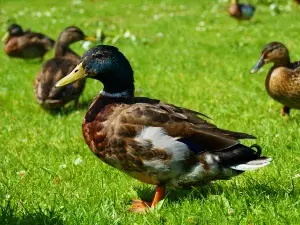
The feet of any animal experience a good amount of wear and tear over the years. The feet are exposed to the dry ground and anything on the ground.
Animal feet are used to being exposed but this doesn’t mean that they don’t also experience wear and tear. If your duck has a callus on its foot this article will be of help to you.
Table of Contents
Callus on a duck’s foot:
If your feet, and or hands, are exposed to repeated friction, irritation, or pressure, then the skin in the area will thicken causing calluses to develop on the area.
This may be what is happening with your ducks, the article below explores how this may have happened and what to do:
How do ducks get calluses?
Ducks get calluses the same way that humans get calluses when skin gets exposed to friction, pressure, or irritation.
These birds, in the wild, are usually found in, and walk around, in areas like streams, ponds, and rivers. The flooring in these areas is usually very soft and easy on the bird’s feet.
If the birds on your property walk on hard surfaces, like concrete, bricks, asphalt, decks, or hard material in their duck houses then the skin under the bird’s feet can become irritated and the birds may develop calluses under their feet.
What to do:
The calluses are actually helping the bird’s feet keeping them protected from any hard surfaces that the duck is walking on. The thick skin keeps the soft tissue of the bird’s feet protected.
Removing the calluses, and not changing the floors, will result in more calluses developing.
However, you may want to intervene if the bird’s calluses start to look brown or black, and if the skin develops deep cracks. Cracks in the skin can lead to an infection
You can treat the bird’s calluses using petroleum jelly. Apply the petroleum jelly to the bird’s calluses and rub it in. Do this every 12 hours for a couple of days to keep the area soft. Make sure that you don’t get the jelly into the bird’s feathers.
Also, make sure that you reach all parts of the calluses not only the top surface of the callus. The calluses will heal by themselves eventually.
If you decide to treat the calluses then you would also need to make the floors that your bird walks on softer and gentler on their feet so that consistent irritation is avoided.
You don’t have to take the bird to the vet as long as the bird is acting normally, that is, as long as the bird is eating and drinking as normal and as long as the bird doesn’t have a limp.
If the bird starts to behave abnormally, then you would need to take the bird to the vet.
How to prevent calluses from developing in the future:
You would need to check if your bird’s houses are set up to adequately house your birds. Make sure that the material at the bottom of your birdhouse is a nice soft material under your bird’s feet.
If your birds are walking on a lot of hard flooring, like concrete, decks, and asphalt then you would need to give them access to water bodies like a pool or a pond which will be easier on their feet.
The difference between bumblefoot and calluses:
How calluses look and how bumblefoot looks can be similar but there are slight differences:
Swelling:
There will be dry tough skin on your duck’s foot if the bird has both bumblefoot and calluses, but the dried skin under your bird’s bumblefoot will be swollen.
Bumblefoot develops when the bird becomes injured under its foot, bacteria enter causing a pus-filled bump under the bird’s foot and a dried skin-looking scab on the bump. Calluses will not have this bump under the dried skin
Number of bumps:
If the bird has calluses then there will likely be one or more patches of dried skin on the bird’s foot, bumblefoot generally causes the bird to develop only one bump and one scab over the bump.
Limping:
Because the calluses are mostly flat the bird won’t have to limp when walking around. The bird will however likely limp if it has bumblefoot as the foot will be quite painful and the bird will be off balance.
If you enjoyed this article then you may also be interested in other chicken related articles. Here are some articles that you may be interested in: Pigeon-Toed Duck, Bow-Legged Duckling, Beak Rot In Ducks, Black Spots On Duck Bill, Black Spot On Duck Foot

